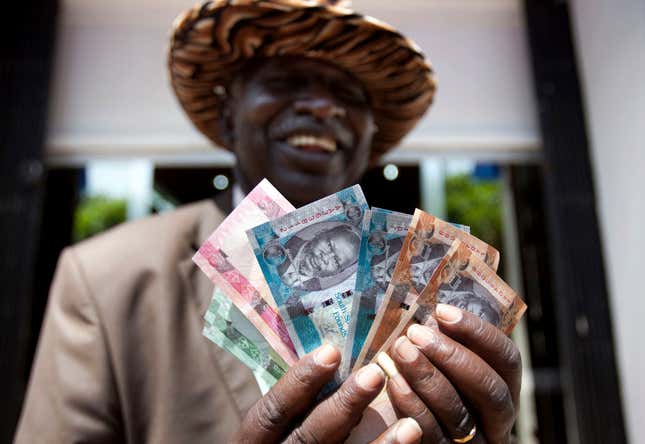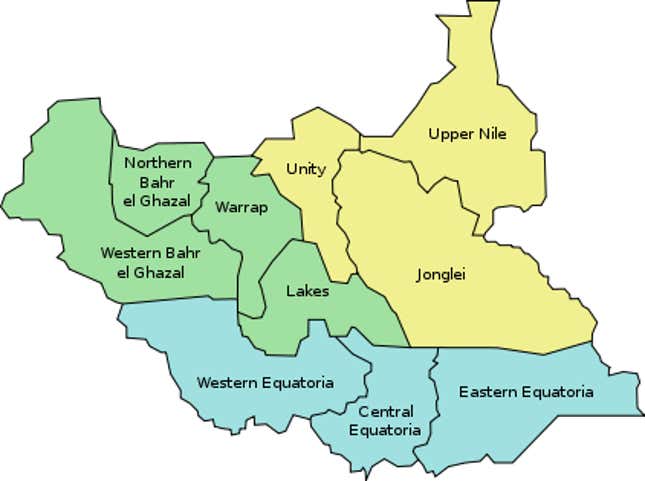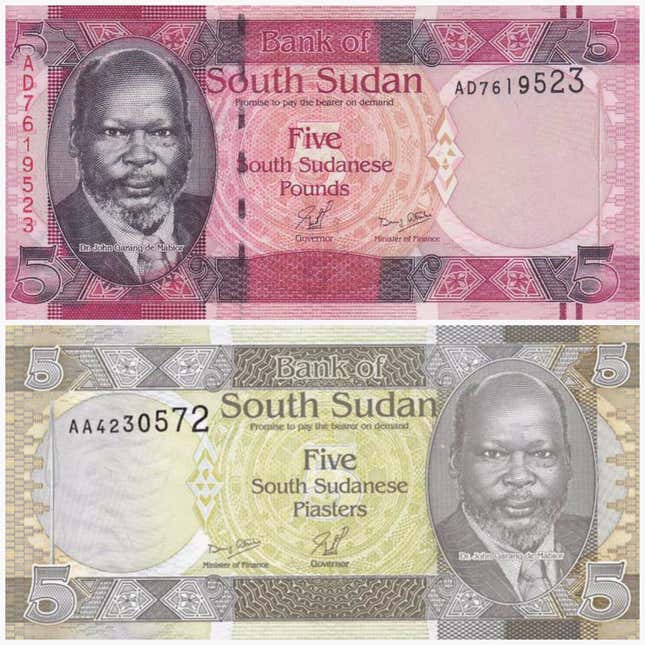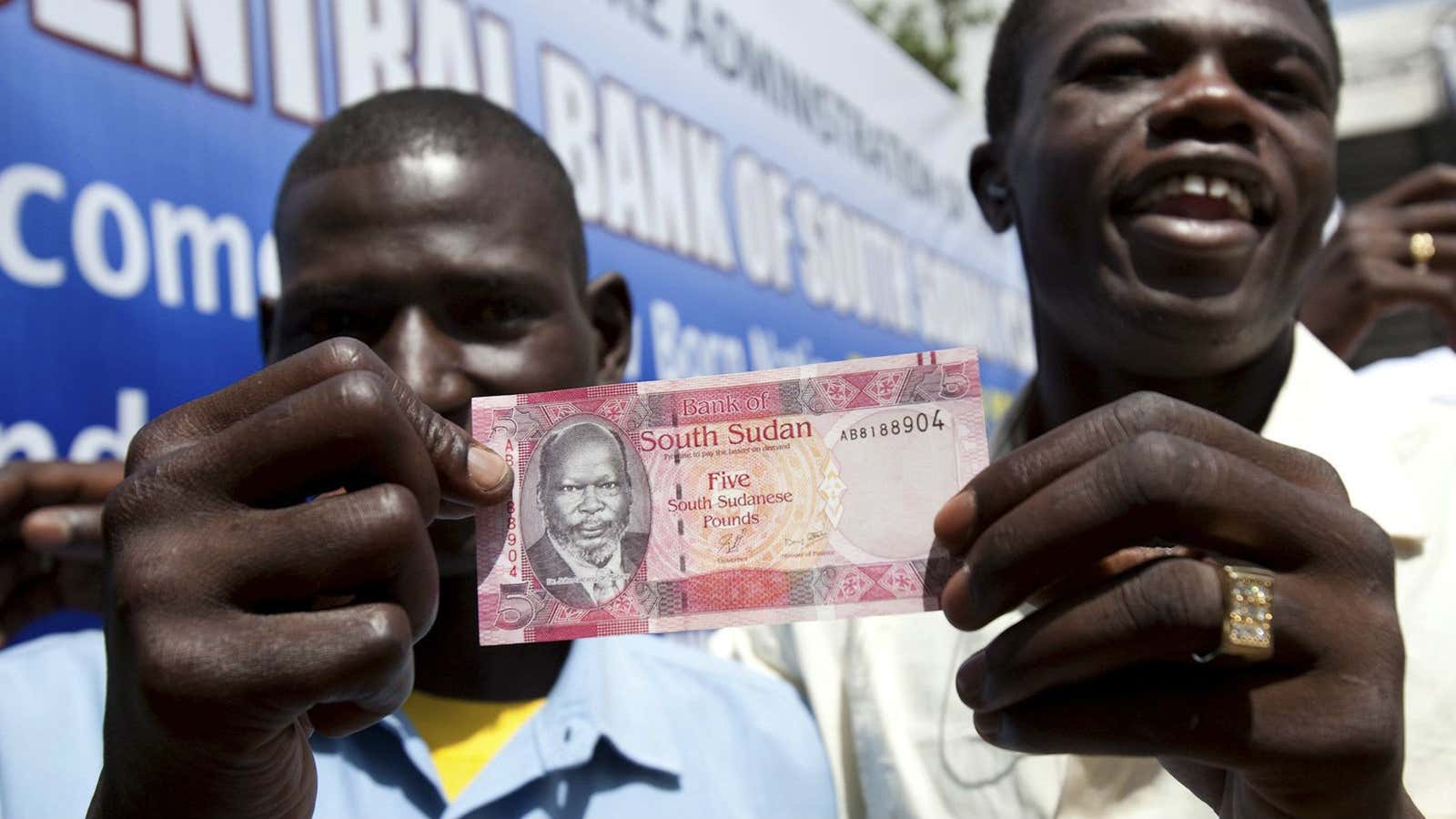To commemorate its fourth year anniversary as a nation, the Republic of South Sudan is set to release its first ever set of coins on Thursday, July 9. The design of the five coins in 10, 20, and 50 piasters as well 1- and 2-pound denominations all feature South Sudan’s coat of arms on one side and motifs representing the geographic regions of South Sudan on the other.
“They are created for those who will buy needles, those who will buy shirt buttons, those who will buy tobacco and so many other small things,” explained central bank governor Kornelio Koriom Mayiik. The 3-piaster coins will be introduced this week and the 1- and 2-pound coins at a later date.
Until the introduction of the coins, the South Sudanese were limited to the six denominations of the South Sudanese pound (SSP) introduced a week after its Independence Day declaration in 2011. This meant that sellers would have to round up prices or had to sell commodities in bulk because there was no monetary instrument to give change. For example, if the cost of a loaf of bread in Juba, its capital city, is SS £5.67 (US $0.95, €0.87) it’s typically rounded up to £6.

The politics of design

In a country with three regions or provinces and 10 ethnically diverse states (pdf), the design of the coins, like South Sudan’s other state symbols, has been a matter of debate, with regions, states, and tribes vying for fair representation.

The chosen motif on the obverse (or “heads”) of the copper-plated steel 10-piaster coin has been particularly controversial. Like the other four coins, its design is adapted from flags and emblems from one of the country’s 10 states—a shoebill stork from the northern Bahr-el Ghazal state symbol on the 20-piaster coin; a white rhino from the Central Equatoria state flag on the 50-piaster coin. But the desert oil-drilling rig motif chosen to represent the Greater Upper Nile region, adapted from the Unity State emblem, has raised issues. The oil rig is a reference to the country’s deep oil reserves but also brings to mind its ongoing conflict with Sudan which controls the oil export pipeline in the region.
It’s a problem “because they put the oil pipe things as their logo which does not reflect the traditional symbol that represent[s] Greater Upper Nile,” said cabinet affairs minister Martin Elia Lomuro in a press briefing last month. “The council discussed thoroughly on the development, design and the logo that these coins will carry,” explained Lomuro about the process monitored by South Sudan’s president, Salva Kiir. “We have noticed that the logo for Greater Equatoria is right as the symbol for Greater Equatoria and the logo for Greater Bahr el Ghazal is correct but the logo for Greater Upper Nile is to be revisited.” Lomuro did not elaborate on an alternative design proposals.
Design redo: Rejected coin vouchers
The new set of coins is actually South Sudan’s second try at producing low value denominations.

Months after introducing the South Sudan pound, which was produced and co-designed with the British banknote manufacturer DeLaRue (pdf), the South Sudan central bank realized the need for a monetary instrument for smaller purchases. But instead of printing coins, South Sudan decided to extend its engagement with DeLaRue and printed more paper money and unveiled a set of piasters or “coin vouchers” on October 2011.
Valued at 1/100th of a pound, the paper equivalent of loose change basically recycled the artwork from the pound by moving the exact portrait of the singular unifying hero, John Garang de Mabior, to the right. Garang was the former leader of South Sudan’s rebellion against Sudan, who was killed in a helicopter crash in 2005. His portrait appears on all denominations of the South Sudan pound and all three piaster note prototypes.
The piaster notes were printed but never circulated. Koryom Mayik told Catholic Radio Network that the notes were rejected because they did not meet “technical requirements.” Noting the similar designs of the bills, it’s highly likely that the piaster notes caused confusion during testing, especially relevant in a population with the world’s lowest literacy rate. These unused piaster notes from the world’s newest nation are now highly covetable commodities on Ebay and numismatic collector sites.
Worn out banknotes
In an interview with The New Nation, central bank deputy governor Jamal Wani said the introduction of the coins will also help replace worn out banknotes. Torn, grimy paper bills are a common sight in South Sudan, with dirt at times obscuring the print and degrading the cotton pulp. There have been cases when customers have refused the worn-out bills, noted Wani. The introduction of the 1- and 2-pound coins will help introduce a more durable monetary instrument for these highly circulated denominations. ”It was a mistake to have one pound notes without coins,” admitted Wani.
The embassy of South Sudan in the US did not have images or details pertaining to the new coins, when Quartz reached out in advance of their release, but recognized that the coins’ introduction was an “important matter for our foreigner investors, world media houses and [e]specially for the public knowledge at large.”
